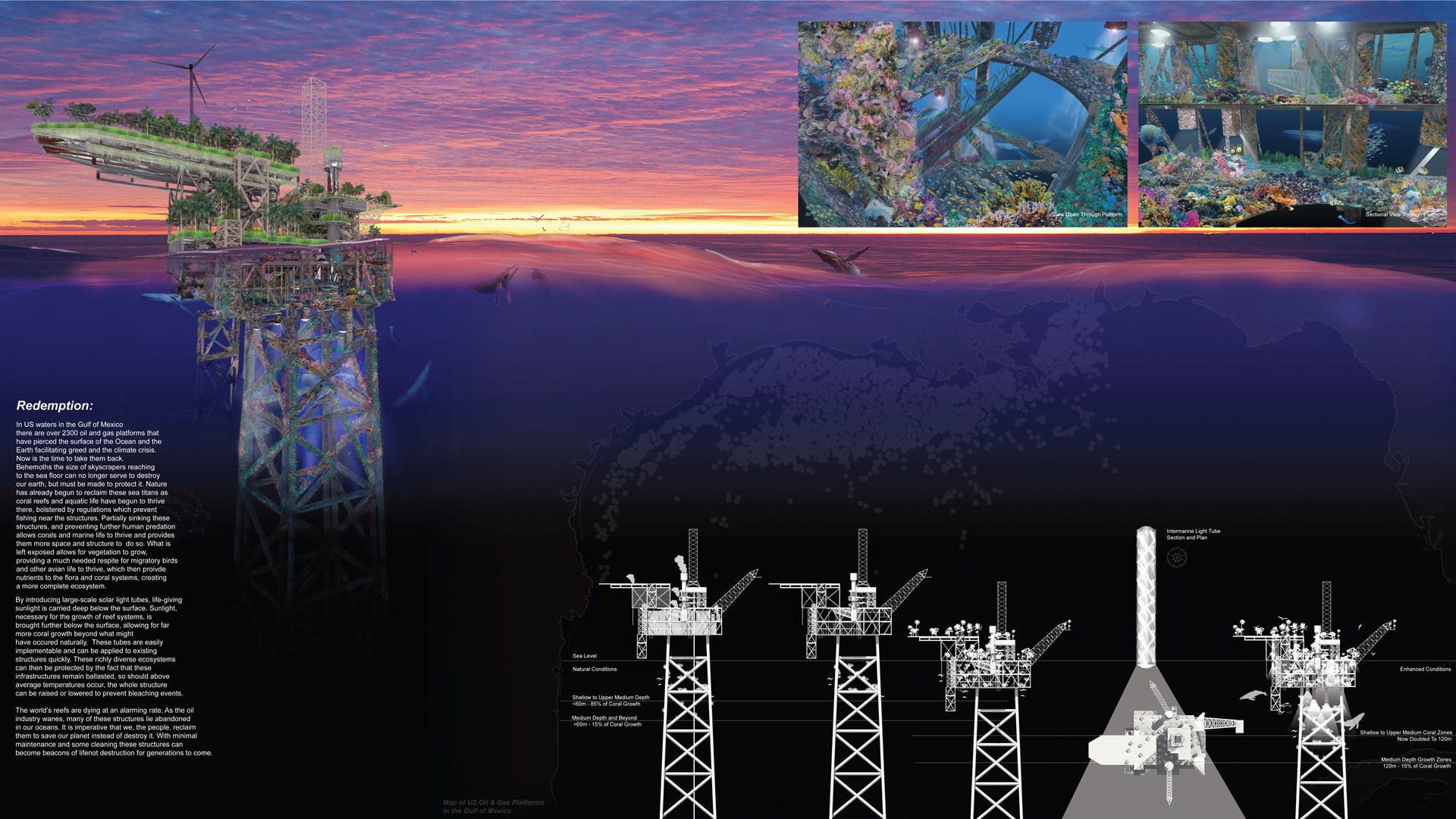Project Description
Offshore oil and gas platforms are immense structures cable to sustain crews of dozens for weeks while processing 100,000’s of barrels of oil and gas per day. “Topsides’ are cities in their own right but they are just the tip of the iceberg. The platforms have structures that extend for miles below the ocean’s surface, and still further penetrate our Earth’s crust. There are around 180 operational platforms in US waters in the Gulf of Mexico alone just to feed our love of fossil fuels that contribute to global warming and oceanic pollution. More shocking is there are a further 2100 sitting unused in US waters in the Gulf. As the world begins to trudge away from fossil fuels there arises a problem of dismantling these immense structures. While they are mobile and can be towed to places for dismantling, doing so costs billions of dollars and is often completed in places that rely on substandard labor practices and leach toxic chemicals into the surrounding environment. Furthermore, in many countries the cost of dismantling is tax deductible, so both oil company and local government are more than happy to let these titans sit and rot in the ocean until they become a “problem.” However, Nature has already found a way to bring life to these machines that once facilitated our current climate crisis. Reefs have begun to develop on these structures in many parts of the world. Corals attach themselves to the undersides while fish and marine mammals thrive due to fishing restrictions surrounding the platforms. These structures have become islands of sanctuary and biodiversity that allow all manner of aquatic life to live in and travel from rig to rig safely without predation from human activity. Noticing this, many governments and environmentalist organizations have begun to clean and sink the rigs so that they can help to fulfill this natural solution. Completely sinking the platforms is shortsighted and a waste of a vast infrastructure that already exists. These titans should be repurposed to more altruistic goals while still providing the precious reef environment. I propose that the structures be sunk, partially. This still allows corals and marine life to thrive yet provides them more space and structure to do so while foliage can grow on exposed areas as well. Lowering only most of the topsides maintains more structure at optimal growth depths rather than committing the behemoths to the black abyss. My architectural intervention seeks to aid Nature’s quest of reclamation. By taking the humble solar light tube, like those seen in houses, and scaling it up, light is brought further into the depths. This maximizes the amount of the structure that coral can thrive on, well below the narrow growth range normally found in nature. Light provides the energy and warmth for coral to grow and sea life to inhabit. Above water, the tubes would elevate slightly, enough to get above any detritus from the foliage, but low enough that a larger wave would clean them off. Most topsides are ballasted, meaning if sea temperature were to rapidly warm the platforms could still be lowered or raised to prevent the catastrophic bleaching events which plague our natural reefs. While the principal idea is to prevent human access, there remains infrastructure to help maintain these structures past their original lifespans to ensure stability in the reefs themselves. As much of the dismantling of oil platforms is tax deductible, these structures already belong to us, the taxpayer. It is our duty to commandeer these structures and turn them into vessels for the protection of our planet. By only partially sinking there exists a possibility to help other seafaring life as well. Planting trees and grasses on the exposed areas of the platforms would help the structures to provide safe havens for migratory and seabirds. The Gulf of Mexico is positioned along several major migratory bird paths between North and South America. By providing safe havens for these birds to rest along the way, it allows them places far away from human interference. These sanctuaries will become even more crucial as habitat loss from rising sea levels continues to affect coastal animal populations. There is also the added benefit that as birds leave their waste and vegetation naturally leaves detritus, nutrients from these will be able to help feed the corals and the flora, creating a more complete ecosystem. Ecosystem preservation and generation must be the priority, which is why I have chosen to focus on that in my renderings and diagrams. Given the sheer number of these structures it is entirely possible to have a several hundred repurposed and relocated for plastic recycling, while others can focus on wind-power generation, and have the remaining 75% of the platforms serve as guardians of a fragile ecosystem for generations to come.
